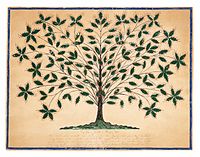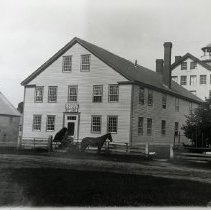Enfield Shaker Museum
Enfield Shaker Historic District | |
NH Route 4A, Enfield, New Hampshire, U.S. | |
| Coordinates | 43°37′13″N 72°8′49″W / 43.62028°N 72.14694°W |
|---|---|
| Area | 1,235 acres (500 ha) |
| NRHP reference No. | 79000198[1] |
| Added to NRHP | November 7, 1979 |
| Community | Enfield Shaker Village, New Hampshire[2] |
|---|---|
| Dates | 1793-1923 |
| Bishopric | Canterbury |
| Spiritual name | Chosen Vale |
| Families | Church, North, South |
| Maximum population | 297 in 1840 |
 |
| Topics |
|---|
| Notable people |
|
Founders
Other members |
The Enfield Shaker Museum is an outdoor history museum and historic district in
One of the buildings, the Great Stone Dwelling, was the largest residential building north of Boston and is the largest Shaker building. When the Shaker community closed, most of the land that made up the Enfield Shaker Village was sold to the Missionaries of La Salette. The state owns 28 acres (11 ha) and 13 buildings, which is now the Enfield Shaker Museum.
Shakers
Village history

The
Within the village was the largest Shaker dwelling and the largest residential dwelling north of
In 1849, the Shakers built the half-mile long Shaker Bridge that crossed a narrow portion of Lake Mascoma to the railroad line.[6] In 1870, the elaborate Victorian and Shaker architectural Ministry shop was built to house the community's religious leaders.[7] To support itself, the community made brooms, buckets, spinning wheels, tubs, dry measures and shirts. It also made and sold applesauce, maple syrup, herbs, medicines and seeds.[6]
Like other Shaker communities, the Enfield Shaker village declined throughout the second half of the 19th century.[7] In 1923, they closed the Enfield Shaker village and moved to the Canterbury community in central New Hampshire.[12]
Much of the village property was sold in 1927 to the La Salettes.[7] The site is listed on the U.S. National Register of Historic Places as the Enfield Shaker Historic District.[1]
-
Brethren Stone Shop
-
Laundry and Dairy buildings
-
Shaker Bridge, 1889
Museum
Since 1986, the Enfield Shaker Museum has worked to preserve the Shaker heritage of the site without neglecting the 20th century history of the village. The Great Stone Dwelling houses the gift shop and the primary exhibition space. The museum is open 7 days a week, offering tours of the site,[7][13] and offers overnight stays in the original Shaker bedrooms of the Great Stone Dwelling.[14]
There are 13 remaining Shaker village buildings and gardens on 28 acres, which can be seen during a self-guided walking tour.[8] The village museum is owned by the state of New Hampshire.[15]
-
Great Stone Dwelling is where the museum, exhibition space, rooms for overnight stays, and the gift shop is located.
Missionaries of La Salette
In 1927, the site was sold to the Missionaries of La Salette, who converted the site into a seminary for the Catholic priesthood, school and conference site.[7][16] The La Salettes built in 1930 the Mary Keane Chapel, a neo-classical revival chapel, which is now part of the museum and open to visitors. The Missionaries of La Salette closed the seminary in 1974, and the center is now known as the Shrine of Our Lady of La Salette, which is a center of "reconciliation".[16]
In 2020, the Missionaries of La Salette announced that the organization would be shutting down operations at the Enfield site, including the Marian shrine located on the eastern slope of Mount Assurance. Sale of the shrine and all accompanying real estate to the Enfield Shaker Museum was completed in July 2023.
-
Mary Keane Chapel
See also
- Enfield Village Historic District
- National Register of Historic Places listings in Grafton County, New Hampshire
- New Hampshire Historical Marker No. 202: The Enfield Shakers
- Shaker Seed Company
- Thomas Corbett (Shaker doctor)
References
- ^ a b "National Register Information System". National Register of Historic Places. National Park Service. March 13, 2009.
- ISBN 978-0-8108-7056-7.
- ^ Enfield Shaker Museum — Reviews and Ratings of Sites in Hanover, The New York Times Travel.
- ^ Shaker Museum, Enfield, NH Map Archived 2008-12-06 at the Wayback Machine, PlanetWare Travel Guide.
- ^ Enfield Shaker Historic District — Shaker Historic Trail, National Park Service.
- ^ ISBN 978-0-8108-7056-7.
- ^ a b c d e f g h Enfield Shaker Historic District. National Register of Historic Places Travel Itinerary. National Park Service. Retrieved March 27, 2014.
- ^ ISBN 978-0-7611-6336-7. p. 70.
- ^ a b Jean M. Burks. Shaker design: out of this world. Yale University Press; 2008. p. 19.
- ISBN 978-1-56898-254-0. p. 184.
- ^ Timothy D. Rieman; Jean M. Burks. Encyclopedia of Shaker furniture. Schiffer; 2003. p. 365.
- ISBN 978-0-8108-6255-5.
- ^ Home. The Enfield Shaker Museum. Retrieved March 28, 2014.
- ^ Stay in the Great Stone Dwelling. The Enfield Shaker Museum. Retrieved March 28, 2014.
- ISBN 978-0-470-73072-0. p. 204.
- ^ a b The Miracle of Enfield: A Vale Chosen by God Himself. La Salette of Enfield. Retrieved March 28, 2014.
External links
- Museum website
- Overnight stays at the Great Stone Dwelling Archived December 11, 2013, at the Wayback Machine
- LaSalette, Center for Reconciliation






